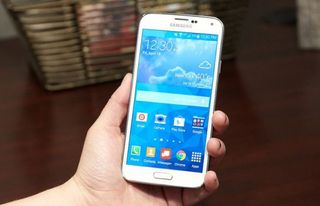iPhone 6 vs. 6 Plus vs. Samsung Galaxy S5 vs. Galaxy Note 4
Here's a side by side comparison of specs and key features of the iPhone 6, iPhone 6 Plus, Samsung Galaxy S5 and the Samsung Galaxy Note 4.

The arms race between Samsung and Apple shows no signs of slowing down. The Samsung Galaxy S5, loaded with a slew of new features including a heart rate monitor and a fingerprint sensor, has been the smartphone to beat for most 2014. Looking to further assert its dominance, the company unveiled the upcoming Galaxy Note 4, which will feature a 5.7-inch, Super AMOLED Quad HD display and a powerful Qualcomm processor.
Not to be outdone, Apple has fired its return salvo in the form of not one, but two smartphones: the iPhone 6 and the iPhone 6 Plus. Outfitted with Retina HD Plus displays and powered by the company's new 64-bit Apple A8 processor with a M8 motion co-processor, these might be the most powerful phones the company has ever made. Boasting thicknesses of 6.9 and 7.1mm with edge-to-edge glass, the iPhone 6 and 6 Plus are the some thinnest, sleekest devices in the company's vaunted history.
Here's how these four titans stack up in terms of features and specs.
| iPhone 6 | iPhone 6 Plus | Samsung Galaxy S5 | Samsung Galaxy Note 4 | |
| Starting Price | Starting at $199 | Starting at $299 | $99 | TBA |
| CPU/GPU | 64-bit Apple A8 processor/M8 motion co-processor | 64-bit Apple A8 processor/M8 motion co-processor | 2.5-GHz quad-core Qualcomm Snapdragon 801 CPU / Adreno 330 GPU with 2GB of RAM | 2.7-GHz quad-core Qualcomm Snapdragon 805 CPU |
| OS | iOS 8 | iOS 8 | Android 4.4.2 | Android 4.4.4 |
| Screen Size | 4.7 inches | 5.5 inches | 5.1 inches, Super AMOLED | 5.7 inches, Super AMOLED Quad HD |
| Resolution | 1334 x 750 pixels, Retina HD | 1920 x 1080 pixels, Retina HD | 1920 x 1080 pixels | 2560 x 1440 pixels |
| RAM | N/A | N/A | 2GB | 3GB |
| Internal Storage | up to 128GB | up to 128GB | 16GB | 32GB or 64GB |
| Expandable Storage | none | none | up to 128GB | up to 64GB |
| Front Camera | 1.2 MP | 1.2 MP | 2 MP | 3.7 MP |
| Rear Camera | 8 MP iSight | 8 MP iSight | 16 MP | 16 MP |
| Battery Life | estimated 10 hours 4G LTE browsing | estimated 12 hours 4G LTE browsing | 9 hours and 42 minutes | Unknown |
| Connectivity | 802.11ac | 802.11ac | 802.11 a/b/g/n/ac | N/A |
| Special Features | Wi-Fi Calling, Digital Image Stablization, Fingerprint scanner | Wi-Fi Calling, Optical Image Stablization | Fingerprint Sensor, Heart Rate Monitor | S Pen with smarter pen apps, Optical Image Stabilization |
| Accessories | Apple Watch | Apple Watch | Samsung Galaxy Gear | Samsung Galaxy Gear S, Samsung Galaxy VR |
| Ports/Slots | Lightning port, headphones | Lightning port, headphones | microUSB, microSD, headphones | microUSB, microSD, headphones |
Design

In terms of design, the iPhone 6 and 6 Plus win hands down. The anodized aluminum curved design, with its extremely thin profile, is what we've come to expect from the brand, and they have not disappointed. It's not a hard stretch of the imagination that both phones will weigh much less than the their counterparts, the Galaxy S 5 and the Note 4.

However, the Galaxy S5's water resistant chassis can withstand a dunking in up to 1 meter of water for 30 minutes, protecting against that inevitable fall into the toilet that will send many an iPhone owner dejectedly to the Genius Bar. Samsung finally caved to user demand and added some metal to the Galaxy design, wrapping the sides of the Note 4 in lightweight aluminum and the back panel in genuine leather for a more premium experience.
Display

The Galaxy S5's 5.1-inch, Super AMOLED display has consistently been one of the brightest, most vivid and accurate panels we've seen -- unless you put it next to an iPhone 5s. While the new iPhone 6 isn't 1080p, the ion-strengthened, 1334 x 750 Retina HD screen packs more pixels into its 4.7-inch display, which should translate into sharper images.
When the iPhone 6 Plus ships, it will feature a Retina HD display like its smaller brethren. However the 6 Plus' 5.7-inch display will have a 1920 x 1080 resolution. The Note 4's 5.7-inch Quad HD panel, on the other hand, will sport a stunning resolution of 2560 x 1440. We'll have to wait until we get both units in house to determine which is better.
Features

In terms of features, Apple added a lot of little tweaks and touches that improve usability. When using the massive iPhone 6 Plus, you can view both your messages and your inbox simultaneously in email, utilize copy and paste buttons on the keyboard and enjoy a sideswipe gesture to go back a page. Apps will also have the ability to automatically scale between devices all the way to the desktop.
On the Samsung front, the Galaxy Note 4 has received an improved S Pen with accompanying apps. The Pen delivers a smoother, more natural writing experience than previous versions. In addition, Samsung has added mouse-like functionality to the Pen allowing you to copy and paste whole sections with a click of the pen.
To combat Samsung's S Health app, both iPhones will have more advanced motion-tracking features courtesy of the M8 co-processor, Both devices will have a barometer, which can measure elevation and distance, in addition to the accelerometer and gyroscope. While the Active version of the Galaxy S5 features a barometer, neither the Note 4 nor the standard GS5 have one. However, both devices will feature a heart rate monitor to help you in your fitness quest.
Camera

Instead of playing the numbers game with its camera, Apple just worked to improve on what it already had. That means that both versions of the iPhone 6 will feature a 8 MP iSight rear camera with a 1.2 MP FaceTime HD camera. The iSight camera has a feature called Focus Pixels which allows for autofocus that's twice as fast as last generation's.
The iPhone 6 Plus will utilize optical image stimulation (OIS) to adjust for natural hand movement when taking pictures, while the iPhone 6 will rely on digital image stabilization. Similar to the iPhone Plus, the Note 4's 16GB rear camera will employ OIS, while the GS5 (16GB) will continue to make use of the digital option.
Megapixels and stabilization options are fine and dandy, but its the features that truly distinguish these four competitors. On the Apple side of things, both devices will have the ability to record 1080p video at 30 fps or 60 fps. For those moments when you need to slow everything now, you can now capture slo-mo video at 120 fps or 240 fps on the iPhone 6. Thanks to the new sensor, selfie fans can expect better face detection and burst selfies from the FaceTime HD camera.
Samsung has yet to announce any new camera features for the Galaxy Note 4, but the Galaxy S5 features Real-Time HDR, Best Shot, Selective Focus and Eraser Mode, the latter of which lets you discretely dispose of any unwelcome photobombers.
Bottom Line
So which shiny new phone should you buy? If you're looking for something a little more pocket-friendly, we recommend the iPhone 6. Once again, Apple has managed to combine drop-dead gorgeous design with impressive power and thoughtful features we didn't think we needed. On the phablet front, we're going with the Galaxy Note 4 for its improved note-taking functions, stunning display and powerful Qualcomm power --the same processor that will power a mobile VR headset when it launches.
Sherri L. Smith is a Senior Writer at Tom's Guide. When she's not reviewing the latest headphones and speakers, you'll find her gaming on her Xbox One, PlayStation 4 or PC. Follow Sherri at @misssmith11. Follow us @TomsGuide and on Facebook.
Sign up to get the BEST of Tom’s Guide direct to your inbox.
Upgrade your life with a daily dose of the biggest tech news, lifestyle hacks and our curated analysis. Be the first to know about cutting-edge gadgets and the hottest deals.
Sherri L. Smith has been cranking out product reviews for Laptopmag.com since 2011. In that time, she's reviewed more than her share of laptops, tablets, smartphones and everything in between. The resident gamer and audio junkie, Sherri was previously a managing editor for Black Web 2.0 and contributed to BET.Com and Popgadget.

